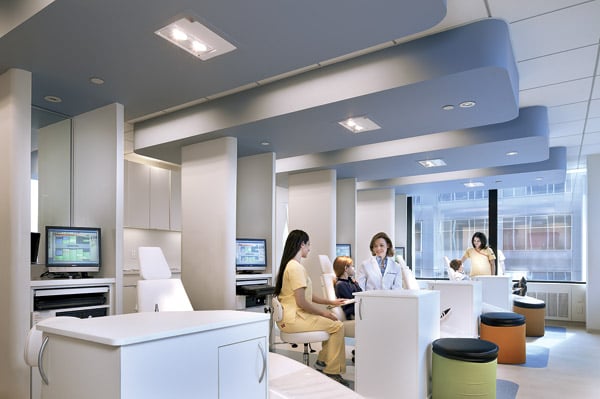1. An Update in Dentist Office Decor
Chic touches make appointments more pleasant
Frosted glass walls. Abstract art. Pops of azure and saffron against white walls. Although it looks like an of-the-moment spa, this 12th-floor aerie with windows framing the clouds is a dentist's office.
"I wanted my office to reflect who I am," says Chevy Chase orthodontist Jill Bruno, adding that the serene feel sends a message that this experience will be different from a typical doctor's appointment.
Andreas Charalambous of DC's Forma Design, the architectural firm responsible, says he believes that "how comfortable a patient feels while waiting is as important as the quality of treatment." His goal? "That people no longer dread going to the dentist."
At Beverly Pediatric Dentistry in McLean, another Forma project, this means a coffee bar for parents, lime-and-yellow-striped treatment rooms, and a Web-surfing station for teens.
Chevy Chase's Obeid Dental, which specializes in implants and prosthodontics, has the look of a hip hotel lounge, with a black wall, white couches, and stone details.
Next: Text-Message Reminders

1. Text-Message Reminders
Now, there's no excuse for forgetting an appointment
Some dentists now let you make appointments via e-mail. Many will text-message patients with reminders that they're due in the next day. When you walk into the Arlington Center for Dentistry, the receptionist gives you a beeper, which vibrates when your dentist is ready.
Next: Advances in Oral Sedation
3. Advances in Oral Sedation
Help reduce anxiety in patients
Oral sedation has lately come into vogue, with many dentists offering this option to patients who have high levels of anxiety.
"You're fully responsive, but in that had-a-couple-of-martinis, feelin'-very-relaxed mode," says Brian Gray, a cosmetic and restorative dentist in DC.

Patients are prescribed anti-anxiety meds such as Valium or Xanax to take before going to the dentist's office (a friend has to drive them). Once there, they're given a stronger sedative such as Halcion, which puts them into a "twilight" yet still conscious state. For some patients, the Halcion in the office can be enough.
Many patients become so relaxed that they feel as if they've slept. When they "wake up" later, they don't remember anything. These patients also receive injected local anesthetics such as lidocaine for pain, but they have no memory of the shot.
Though sedation dentistry is relatively safe, it's important for vital signs such as blood pressure and pulse to be continually monitored with an oximeter during the procedure.
IV sedation, in which a patient is put into a deeper twilight state, has also become more popular, especially for lengthy or invasive procedures such as oral surgery. It's important to have an anesthesiologist on the premises should something go awry.
Next: Play with A Puppy Before Your Treatment
4. Play With a Puppy Before Your Treatment
Hershey kisses and watching a movie help patients relax

Greater attention to architecture and interior design isn't the only way the dental experience is changing.
Chances are that a Jack Russell terrier named Disco will greet you at the DC or Alexandria office of DC Smiles. "He's the most popular member of our team," says Lawrence Singer, a hospital dentist who also does implants, cosmetic dentistry, and general reconstructive surgery. Like Singer, Disco flip-flops between the two offices.
Anxious patients can pet Disco during treatments—the dog has pet-therapy certification, which means he's been tested to ensure he remains even-tempered in a medical setting. Studies have shown that spending 15 minutes a day with a pet can reduce stress.
Pet therapy is unusual, but many dentists offer distractions such as flat-screen TVs in treatment rooms, DVD libraries, and iPods to reduce anxiety.
At DC's Washington Center for Cosmetic Dentistry, there are neck pillows, hot towels, cucumber-scented eye pads, blankets, and dental chairs outfitted with gentle massagers for the lumbar and back.
Pediatric dentist Dana Greenwald in Friendship Heights has been offering spa-like perks for her young patients for 19 years. Dental visits end with nail polish with funky designs (boys go for this, too), stickers, toys, faux tattoos, and sometimes even Hershey kisses to counter the "yucky" taste of bonded fillings and anti-cavity fluoride varnish treatments.
John Kling II, a general dentist in Alexandria, does deep-breathing exercises with some patients. His office has a relaxation room with a recliner, a flat-screen TV, and soothing tunes. Kling says the most effective distractions are noise-reducing earphones and a pair of black Vuzix iWear goggles that block outside light and create a giant virtual screen for watching movies, TV shows, or music videos: "This single device has decreased anxiety levels more than all others. A patient can get lost in a movie and not worry about what I'm doing."
Next: No More Mumbling

5. No More Mumbling
One shot and you're ready to give a speech
Have to give a speech after a visit to the dentist's office and don't want to be tongue-tied because your mouth is numb? OraVerse is a new drug dentists can inject to quickly reverse the effects of dental anesthetics such as lidocaine. Your mouth could feel normal before you leave the dentist, and because your gums are already numb, you won't feel the shot.
Next: Same Day Implants
6. Same-Day Implants
Minimal pain and quicket healing

A dental implant used to be a drawn-out affair, requiring visits to the dentist over a period of six months to a year. The tooth had to be pulled, and tiny metal screws were surgically placed into the jaw. Post-op was painful, and there was risk of infection. After the implant healed, a second surgery connected a metal post to the original implant. Attaching a crown, or artificial tooth, to the post was the last stage.
Cone-beam high-definition scanners have changed that. Introduced in the US in 2001, these machines have grown more popular. Using this technology, dentists can take three-dimensional pictures of the teeth, enabling them to plot where the implant should go. "We can pre-do surgery on a computer screen, and the crowns can be premade, too," says hospital dentist Lawrence Singer.
Once the digital scan is taken, the whole procedure, including attachment of crowns, can be wrapped up in one visit. In most instances, this approach eliminates surgically cutting into the gum, which means a local anesthetic can be used instead of IV sedation and there's minimal pain and quicker healing.
Single-day implants aren't for everybody. Patients need to have enough bone to hold the implant; otherwise, bone has to be grafted, a more involved scenario. Some denture wearers who require a mouthful of implants aren't candidates for single-day implants, either. Also important to know: The cone beam emits more radiation than a traditional dental x-ray but much less than a medical CT scan.
Next: Saliva Tests for Oral Cancer
7. Saliva Tests for Oral Cancer
These tests can also be used to for HPV and gum disease

Many dentists now offer salivary tests for oral cancer, which can be hard to detect visually; the human papilloma virus; and periodontal disease, which has been linked to inflammation and heart disease, some cancers, and other ills. Because the tests cost $50 to $150, most dentists recommend them only if you're at high risk for oral cancer or if there's a need to identify a pathogen—as in a persistent case of periodontal disease.
There are already saliva tests for HIV and hormone levels, though these are done at the physician's office rather than at the dentist's. On the horizon: using saliva as a diagnostic tool for disease. Researchers are working on identifying biomarkers for different illnesses and developing techniques for fast saliva-based testing.
Next: New Root Canal Procedures
8. Not Your Parent's Root Canal
High-definition scanners have transformed this tricky procedure

High-definition scanners have made the endodontist's job easier, too. Being able to get a high-quality 360-degree image of a tooth and the surrounding gum helps an endodontist see hairline fractures that would be hard to detect with even the finest dental x-rays.
Root canals—tooth-saving procedures in which an inflamed or infected nerve of a tooth is cleaned out and sealed—can be tricky. If there's a fracture in the root or an infection in the gum in which the decayed tooth sits, the root canal may not take and the patient could feel discomfort. At some point, the tooth will have to be removed.
"Having a 360-degree perspective enables us to detect the smallest fractures that make teeth hurt," says Chevy Chase endodontist Pirooz Zia. That can mean better diagnosing and fewer visits to the dentist. Says Zia: "This is revolutionizing the way we diagnose. It's taking away the guesswork."
The three-dimensional image also helps the endodontist by providing a road map to the labyrinthine canal system under a tooth. During a root canal, this area is cleaned out to avoid infection. Zia notes that infections in the roots of upper molars are often the undiagnosed culprits in chronic sinus infections. Patients can sometimes avoid sinus surgery by ruling out dental infections first.
Next: Getting Rid of Laugh Lines
9. Getting Rid of Laugh Lines
Fixing your teeth can have additional cosmetic benefits

Think of it as dental work with benefits: Implants, veneers, and other procedures that restore the height of teeth also can soften lines around the nose and mouth.
To get an idea of how teeth support the face, think about how someone looks when his or her dentures are out. In addition to restoring your pearly whites, veneers and crowns can add more fullness to the lips. Implants can do the same by filling in gaps where teeth are missing or broken.
Even a slight change in what Fairfax cosmetic dentist Gordon Rye calls "vertical dimension"—which we all lose as teeth get worn down with age—can make the corners of the mouth turn down, jowls more prominent, and "marionette lines" deeper. Procedures that restore height to the teeth have a smoothing effect on the lower face.
Michael Pollowitz, a general and cosmetic dentist in DC, says the loss of collagen and fat in the face as we age makes teeth more important as support structures. Like many other cosmetic dentists, Pollowitz works with a plastic surgeon when a patient wants full facial rejuvenation—often the teeth are the first salvo. Orthodontist Jill Bruno and her husband, Jim Bruno, a plastic surgeon, coordinate orthodontic, surgical, and cosmetic procedures at their Center for Facial Harmony in Chevy Chase.
If you're thinking about undergoing major dental work just to banish lines—and not because the teeth need repair—you might consider this: Though results are longer-lasting than with Botox or fillers, this approach is far more expensive than injectables.
Next: Why Early Braces Might Be Necessary
10. Braces Now or Later?
A few reasons why early braces might be necessary

Braces used to be a teenage rite of passage. But these days you see six-, seven-, and eight-year-olds with mouths full of metal. Early braces are controversial with parents, who question whether they're truly necessary.
According to orthodontist Jill Bruno, early braces aren't needed for crowding or overbites, so you might seek a second opinion if your orthodontist is pushing them. They can, however, be helpful in some instances. These include a cross bite, in which the upper teeth fall inside the lower teeth when biting down. Left untreated, this can throw off the symmetry of the face.
When there's a significant skeletal discrepancy, early braces are also a good idea. This might be a large lower jaw with a small upper jaw ("Think Jay Leno," says Bruno) or vice versa. If you don't correct such a condition with braces early, surgery or extensive treatment may be needed later.
Teeth growing in crooked or twisted require early braces because they're more vulnerable to breaking.
Next: Good News for the Needle-Phobic
11. Good News for the Needle-Phobic
New drills are less invasive

Does the mosquito-like whir of the drill make you want to jump out of the dentist's chair? Many dentists such as Brian Gray are using new, quieter electric handpieces instead of air-driven drills.
If a cavity is superficial, the dentist may not even have to use a drill. A new handpiece that essentially "power-washes" away decay with abrasive powder can be used instead, often without any anesthetic. It's especially helpful for decay in baby teeth and for first-time cavities in adult teeth.
Good news for the needle-phobic are new gizmos such as the Wand. DC dentist Paul LaRose uses it to inject dental anesthetic very slowly into the gums—the pain most patients feel when receiving an injection is from the amount of fluid, not the needle itself. The Wand gauges the optimal flow rate for the amount of anesthetic being used, says LaRose. Many dentists have been doing this manually for years.
This article first appeared in the April 2011 issue of The Washingtonian.
Subscribe to Washingtonian
Follow Washingtonian on Twitter
More >> Top Dentists | Clean Teeth—Better Health? | Sports Dentists Sound Off


















